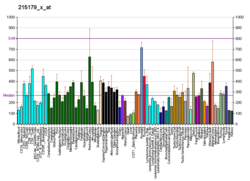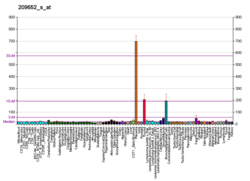Facteur de croissance placentaire
Le facteur de croissance placentaire (donc l’abréviation courante est PlGF pour placental growth factor) est une protéine facteur de croissance dont le gène est situé sur le chromosome 14 humain.
Il est exprimé dans le cytotrophoblaste et le syncitiotrophoblaste[5]. En cas de grossesse, son taux sanguin augmente chez la mère jusque la trentième semaine d'aménorrhée[6]. Un niveau bas de cette protéine est corrélé avec le risque de survenue d'une pré-éclampsie[7] et le dosage est d'autant plus bas que la pré-éclampsie est sévère[8], constituant un indice pronostique[9]. Son taux est très sensible et a une bonne valeur prédictive négative. Sa spécificité est plus faible[10].
Dans la drépanocytose, le PIGF serait un facteur aggravant de l'inflammation[11] et pouvant favoriser l'apparition d'une hypertension artérielle pulmonaire par plusieurs mécanismes : activation du PAI-1[12] favorisant la formation de thromboses, de l'apoptose des cellules épithéliales pulmonaires[13], des leucotriènes[14], entraînant une hypersensibilité des voies respiratoires, conjointement avec l'interleukine 13[15].
Il intervient dans la genèse d'autres maladies pulmonaires, comme dans l'emphysème[16].
Notes et références modifier
- GRCh38: Ensembl release 89: ENSG00000119630 - Ensembl, May 2017
- GRCm38: Ensembl release 89: ENSMUSG00000004791 - Ensembl, May 2017
- « Publications PubMed pour l'Homme », sur National Center for Biotechnology Information, U.S. National Library of Medicine
- « Publications PubMed pour la Souris », sur National Center for Biotechnology Information, U.S. National Library of Medicine
- (en) Shore VH, Wang TH, Wang CL, Torry RJ, Caudle MR et Torry DS, « Vascular endothelial growth factor, placenta growth factor and their receptors in isolated human trophoblast », Placenta, vol. 18, no 8, , p. 657–665 (DOI 10.1016/S0143-4004(97)90007-2, lire en ligne).
- (en) Knudsen UB, Kronborg CS, Von Dadelszen P, Kupfer K, Lee SW, Vittinghus E, Allen JG et Redman CW, « A single rapid point-of-care placental growth factor determination as an aid in the diagnosis of preeclampsia », Pregnancy Hypertens, vol. 2, no 1, , p. 8–15 (DOI 10.1016/j.preghy.2011.08.117, lire en ligne).
- (en) Levine RJ, Maynard SE, Qian C et al., « Circulating angiogenic factors and the risk of preeclampsia », N Engl J Med, vol. 350, no 7, , p. 672–683 (DOI 10.1056/NEJMoa031884, lire en ligne).
- (en) Robinson CJ, Johnson DD, Chang EY, Armstrong DM et Wang W, « Evaluation of placenta growth factor and soluble Fms-like tyrosine kinase 1 receptor levels in mild and severe preeclampsia », Am J Obstet Gynecol, vol. 195, no 1, , p. 255–259 (DOI 10.1016/j.ajog.2005.12.049, lire en ligne).
- (en) Sibiude J, Guibourdenche J, Dionne MD, Le Ray C, Anselem O, Serreau R, Goffinet F et Tsatsaris V, « Placental growth factor for the prediction of adverse outcomes in patients with suspected preeclampsia or intrauterine growth restriction », PLoS ONE, vol. 7, , e50208 (DOI 10.1371/journal.pone.0050208, lire en ligne).
- (en) Chappell LC, Duckworth S, Seed PT et al., « Diagnostic accuracy of placental growth factor in women with suspected preeclampsia: A prospective multicenter study », Circulation, vol. 128, no 19, , p. 2121-2131 (DOI 10.1161/CIRCULATIONAHA.113.003215, lire en ligne).
- (en) Perelman N, Selvaraj SK, Batra S et al., « Placenta growth factor activates monocytes and correlates with sickle cell disease severity », Blood, vol. 102, no 4, , p. 1506–1514 (DOI 10.1182/blood-2002-11-3422, lire en ligne).
- (en) Patel N, Sundaram N, Yang M, Madigan C, Kalra VK et Malik P, « Placenta growth factor (PlGF), a novel inducer of plasminogen activator inhibitor-1 (PAI-1) in sickle cell disease (SCD) », J Biol Chem, vol. 285, , p. 16713–16722 (DOI 10.1074/jbc.M110.101691, lire en ligne).
- (en) Hou HH, Cheng SL, Liu HT, Yang FZ, Wang HC et Yu CJ, « Elastase induced lung epithelial cell apoptosis and emphysema through placenta growth factor », Cell Death Dis, vol. 4, , article no e793 (DOI 10.1038/cddis.2013.329, lire en ligne).
- (en) Patel N, Gonsalves CS, Yang M, Malik P et Kalra VK, « Placenta growth factor induces 5-lipoxygenase–activating protein to increase leukotriene formation in sickle cell disease », Blood, vol. 113, no 5, , p. 1129–1138 (DOI 10.1182/blood-2008-07-169821, lire en ligne).
- (en) Eiymo Mwa Mpollo MS et al., « Placenta growth factor augments airway hyperresponsiveness via leukotrienes and IL-13 », J Clin Invest, vol. 126, no 2, , p. 571-584 (DOI 10.1172/JCI77250, lire en ligne).
- (en) Tsao PN, Su YN, Li H et al., « Overexpression of placenta growth factor contributes to the pathogenesis of pulmonary emphysema », Am J Respir Crit Care Med, vol. 169, no 4, , p. 505–511 (PMID 14644931, DOI 10.1164/rccm.200306-774OC, lire en ligne).






